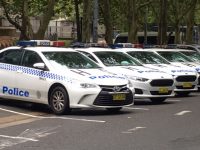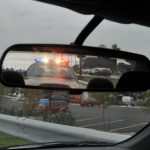Despite Fatalities, NSW Police Increase the Use of Lethal Pursuits

A NSW police highway patrol car slammed into the vehicle of Gai Vieira at an intersection in Cronulla on 5 September. At the time of the collision, the Traffic and Highway Patrol Command officer was in pursuit of another driver who was reportedly using their mobile phone.
As a result of the accident, Ms Vieira suffered broken bones, punctured lungs and head trauma. And the 68-year-old Sydneysider remains in a coma four weeks later.
The 40-year-old NSW police senior constable was allegedly travelling at 124 km/h in a 70 zone without using his lights or siren, when he smashed Ms Vieira’s car. He was charged last week with dangerous driving causing grievous bodily harm and will appear in court in November.
On the day after the officer was charged, the Redfern Legal Centre released figures from an analysis of NSW police data it’s been undertaking, which showed that rather than pulling back on high-speed pursuits, the police force has actually ramped up its use of this lethal practice.
Over a three year period, the amount of high-speed chases NSW police has engaged in has increased by 37 percent. In 2014-15, police were involved in 1,801 pursuits, whereas, in the year 2016-17, the number had spiked to 2,472 chases.
No justification
“The continued reliance on lethal pursuits by NSW police is both unjustified and out-of-step with best practice,” said Samantha Lee, head of police accountability practice at the Redfern Legal Centre.
The analysis of police data further found that over the three year period, there were six fatalities, the number of collisions had risen by 24 percent, while the number of injuries had fallen by 10 percent.
And less than 10 percent of the 2,472 high-speed pursuits carried out in 2016-17 were in relation to criminal activity, which means police are risking the lives of the public as they try and apprehend people over traffic offences, stolen vehicles and failing to pull over for random breath testing.
“Even if police were to apply a cost and benefit analysis to the situation, the costs would outweigh the benefits hands down,” Ms Lee told Sydney Criminal Lawyers®. The costs include personal injury and death, as well as “the huge emotional toll such pursuits have on the community and police.”
An antiquated practice
“The NSW police’s addiction to high-speed chases is lethal and needs to be dealt with,” NSW Greens MLC David Shoebridge said. “This is a negligently dangerous policy that puts NSW well out of step with the more safety-conscious policies in Queensland, Tasmania and Victoria.”
Tasmania banned high-speed pursuits for minor offences – such as traffic infringements – as far back as 1999. This has resulted in deaths and injuries almost being completely eliminated. And Queensland followed suit with a similar policy in 2012.
Victoria police updated its pursuit policy in June 2015, so that officers can only pursue a vehicle under exceptional circumstances, which include when a pursuit is deemed necessary to prevent serious risk to public health and safety, or if a criminal offence has taken place or is about to.
“The police pursuit policy operating in NSW has become outdated in light of moves made in the other jurisdictions towards a model that privileges public safety as the top priority,” Ms Lee made clear. She added that this state has also failed to implement a risk assessment tool like the others.
A veil of secrecy
NSW police began publishing its pursuit statistics following a 2014 coronial recommendation. The 2016-17 annual report outlines that there were two fatalities caused by pursuits that year, one of which involved police chasing a teenager for 50 kilometres along the Pacific Highway.
However, NSW police is notoriously secretive about its pursuit policy, as well as being laxed about updating it. Despite being required to review its Safe Driving Policy once a year, between 2010 and 2015 it didn’t. And since it was updated in 2016, the policy has never been released to the public.
Ms Lee explained that police were reluctant to release the policy on the basis it “will inform potential lawbreakers how to avoid police pursuits.” But this, she says, is outdated as new technology allows police “to track down offenders days after an offence has occurred.”
“Police pursuits have had horrific consequences on many people, including innocent bystanders, ambulance service, witnesses and even police themselves,” Ms Lee continued. “For this reason, the public should be informed about a policy which has wide ranging ramifications.”
Unwilling to change
NSW police commissioner Mick Fuller told reporters last week that police pursuits could be banned, but it would come at a cost. “There’s a price to pay for public safety,” he said, “but it’s important we continue to debate police tactics versus public safety.”
The state’s top cop suggested that figures showed the banning of high-speed pursuits led to crime rates rising. “We’ve seen it in other states. We’ve seen it in London in terms of their robbery rates once pursuits were stopped, they went up exponentially.”
In 2016, NSW police minister Troy Grant stated that the review of the Safe Driving Policy had considered coronial recommendations, such as not pursuing vehicles for minor offences. And he said that changes to the policy had been made in light of these considerations.
But, obviously, as the tragic accident involving Gai Vieira reveals, the changes to the secretive policy do not prevent officers of the law carrying out high-speed pursuits when a driver is seen to be using their mobile phone.
Same old NSW police
“The review delivered no material change and ignored international best practice in reducing fatalities and serious injuries caused by police car chases,” Mr Shoebridge said, adding that it’s “no wonder they are hiding such a self-serving and inadequate internal review.”
The NSW Greens justice spokesperson said he’s been tracking police pursuit data for years, and NSW police has the most aggressive high-speed pursuit policy in the country. And he stressed that the majority these dangerous chases are in the pursuit of “traffic matters not chasing bank robbers.
“Like so much of NSW police practices it is based on politics and a tough law and order stance,” Mr Shoebridge concluded, “not evidence and public safety.”
Going to court for a traffic offence?
If you are going to court for a traffic offence, call or email Sydney Criminal Lawyers anytime to arrange a free first consultation with an experienced, specialist traffic lawyer who will accurately advise you of your options, the best way forward, and fight for the optimal outcome in your specific situation.







